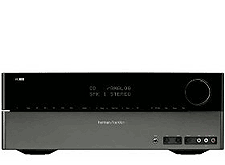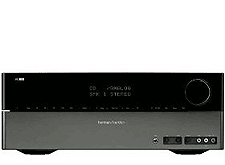


The Harman Kardon HK 3390 stereo receiver (suggested retail price: $399) is a solid choice for anyone who wants to build a high-quality music system on a budget or add good-sounding audio to their home entertainment system, but can't accommodate a surround sound set-up.
Additional Resources
• Read more receiver reviews from HomeTheaterReview.com.
• Explore audiophile-grade source components in our Source Component Review section.
The HK 3390 is more versatile than the typical stereo receiver of old, since it also has video, along with audio switching capability. It can accommodate A/V source components such as a cable box or gaming system, albeit only via composite video connections. The HK 3390 delivers 80 watts per channel into eight ohms (100 wpc into four ohms) and offers seven audio inputs, including a moving-magnet-cartridge phono input and a 3.5-millimeter mini jack for connecting an iPod or portable audio player. Four composite video inputs are provided, along with a composite video output. Additional connection facilities include a headphone jack, tape monitor loop, A/B speaker switching, two subwoofer outputs, preamp outputs and power amp inputs, a composite video output, IR in/out jacks and two switched AC convenience outlets. The receiver has an FM/AM tuner with 30 station presets, and comes with a remote control that can also operate other Harman Kardon components. Note those dual subwoofer outputs: they enable the user to create a two-speakers-plus-subwoofer set-up in two rooms, or a two-speaker/two-subwoofer set-up in the main home theater room. The HK 3390 is also an extremely attractive piece of home audio gear, thanks to its two-tone gloss black and dark gray front panel and curved sides, which set it apart from the typical black box with knobs.
Harman Kardon components have a heritage of delivering good sound and the HK 3390 is no exception. Like all Harman Kardon stereo and A/V receivers, it incorporates the company's long-standing high-current, ultrawide-bandwidth amplifier designs with discrete output transistors. As a result, the HK 3390's sound is clear, powerful and detailed, and the receiver can easily drive most loudspeakers (excepting some exotic audiophile models) to generous volume levels without strain. The HK 3390, like its bigger brother, the HK 3490, leans more towards the warm and rich side, rather than the lean and bright, although certainly not to an excessive degree.
Competition and Comparison
To compare Harman Kardon's HK 3390 receiver against its competition, read our reviews for the NAD C 725BEE and the Onkyo TX-SR575. There are more reviews available in our Receiver review section. There is also more information available on our Harman Kardon brand page. Discuss Stereo Receivers at hometheaterequipment.com.

High Points
• The HK 3380 features a total of seven audio and A/V inputs to accommodate multiple source components, including a turntable. Vinyl is making a comeback with the kids, they say.
• The receiver delivers outstanding sound quality, with 80 watts of power per channel into eight ohms (120 wpc into four ohms).
• The HK 3390 has a sleek, stylish appearance that looks right at home next to a flat panel TV.
• The receiver's A/B speaker outputs and two subwoofer outputs enable multi-room music playback and greater subwoofer installation versatility.
Low Points
• There are no HDMI, component or S-video connections. The HK 3390 is more an audio receiver with extra video capability than a full-fledged audio/video receiver.
• The HK 3390 does not have a dedicated input for an iPod docking station (although an iPod can be connected via the 3.5mm audio input jack).
• The receiver does not offer any virtual surround listening modes.
Conclusion
The Harman Kardon HK 3390 stereo receiver is an excellent-sounding receiver that offers connections to accommodate more than a half-dozen source components, including a phono input for turntable enthusiasts, and composite video inputs and outputs. The receiver's 80-watt-per-channel power output enables it to drive a wide range of loudspeakers to generous listening levels, while offering the convenience of remote control operation.
Additional Resources
• Read more receiver reviews from HomeTheaterReview.com.
• Explore audiophile-grade source components in our Source Component Review section.
2023-07-29 17:22:06
That's not good. Usually that indicates either a load (short or near-short) or amp output circuit problem. To troubleshoot: 1. Unplug everything from the receiver but leave the power cord plugged into AC. Turn it on and run the volume control up and down a few times. If no warnings, step 2. With receiver power off, Plug RCA cable from turntable into unit's phono input. 3. Repeat step 1. If no problems, step 3. Patch a pair of speakers that work but that you don't care about with cables terminated, preferably, with spade lugs or banana plugs into the receiver's speaker 1 terminals, Step 4. With volume at minimum, place a record on the turntable and begin playing in whatever manner is usually employed. Step 5. Slowly advance volume control, listening for anomalies and watching for error messages. Take it to a moderately loud level (-12db if you can get that far). if no problems, repeat with speaker 2 terminals. If still no errors, you should be good. if your "Amp protect" message comes on at any point, record the action you took immediately prior. If the error showed with no speaker load but the turntable patched in, using an ohmmeter, check resistance between the pins and shield of TT RCA plugs. It's rare for a shorted input to cause the symptom you're describing, but weird things do happen. If the error came after a speaker load was connected but no program was playing, (with power off) check speaker terminals minus speaker wire for shorts. If none found, connect speaker cables, but leave speakers disconnected. Make sure bare (speaker) ends of wire aren't touching. If still no problems, (with power off), connect speakers. If you have an error with speakers connected you, obviously, have one or more bad (shorted) speakers. Using an ohmmeter, check resistance across speaker input terminals. Typically, you should read about 60-70% of the nominal impedance since you're only looking at the DC resistance of the voice coil, usually of the woofer only. For instance, an 8 ohm speaker should read between 5.5 and 7.5 ohms. Substantially less means a shorted or partially shorted voice coil, and this is what is screwing up your amplifier.At this point you can either replace the damaged component(s) in your speaker(s), or buy new ones. Hope this helps. BTW, I'm a military trained radar technician with 8 years field experience and a self-trained sound reinforcement engineer with 20+ years experience designing, building, installing, and operating professional concert audio systems. I also sold hi-fi gear in my younger days.
2022-11-12 18:26:16
My Harmon Kardon 3390 has been working well for years. Recently when I try to play an LP on y turntable, the receiver flips back to standby and i get the message "Amp Protect ... check amp" and then it shuts down. Ideas?